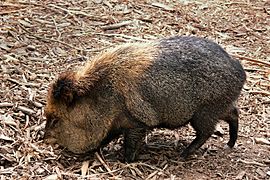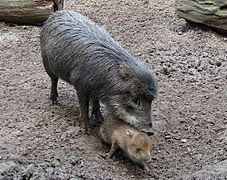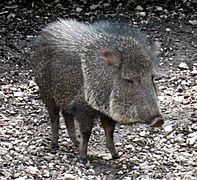Peccary facts for kids
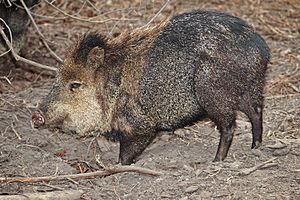
A peccary (say: PEK-uh-ree) is a medium-sized mammal that looks a lot like a pig. People sometimes call them javelinas or skunk pigs. They are hoofed animals, meaning they walk on hooves. Peccaries live in Central America, South America, and the southwestern parts of North America.
These animals usually grow to be about 90 to 130 centimeters (3 to 4 feet) long. A grown-up peccary typically weighs between 20 to 40 kilograms (44 to 88 pounds).
Peccaries are native to the Americas. They are often confused with pigs, which originally came from Africa and Europe. Sometimes, domestic pigs brought by settlers have escaped and now live in the wild. These wild pigs are often called "razorbacks."
In many countries, especially developing ones, people keep peccaries as pets. They are also raised on farms to provide food for local communities.
Contents
What's in a Name?
The word peccary comes from an old Carib language word. That word was pakira or paquira.
Peccary Characteristics
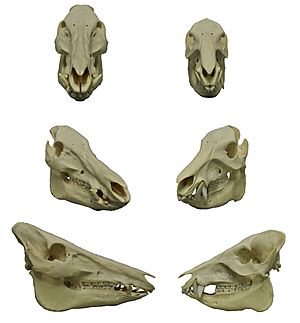
Peccaries are medium-sized animals that look very much like pigs. Like pigs, they have a snout that ends in a tough, round disc. Their eyes are quite small compared to their heads.
When they walk, peccaries use only their two middle toes. Unlike pigs, their other toes might not even be there. Their stomachs have three parts, which is more complex than a pig's stomach.
What Peccaries Eat
Peccaries are omnivores, which means they eat both plants and animals. They will munch on insects, grubs, and sometimes even small animals. However, they mostly prefer plant foods. Their favorite meals include roots, grasses, seeds, fruits, and cacti. They especially love prickly pear cacti.
Their Special Tusks
You can tell the difference between a pig and a peccary by looking at their teeth. Pigs have long tusks that curve around. Peccaries, however, have short, straight tusks. These tusks are perfect for crushing hard seeds and slicing into plant roots. Peccaries also use their tusks to defend themselves from predators.
When peccaries rub their tusks together, they make a chattering sound. This noise warns other animals to stay away. Sometimes, large groups of peccaries have been known to hurt people when they feel threatened.
Social Life of Peccaries
Peccaries are social animals and often live in groups called herds. Some herds of white-lipped peccaries can have over 100 individuals! However, collared and Chacoan peccaries usually live in smaller groups. Living together helps them protect their territory and stay safe from predators. It also helps them control their body temperature and interact with each other.
Scent Glands and Communication
Peccaries have special scent glands. They have one below each eye and another on their backs. They use these glands to mark their herd's territory. These territories can be quite large, from 75 to 700 acres (0.3 to 2.8 square kilometers).
They also use their scent glands to mark other members of their herd. They do this by rubbing against each other. This strong smell helps peccaries recognize who belongs to their group. This is very important because peccaries don't have very good eyesight. The smell is so strong that humans can notice it, which is why peccaries are sometimes called "skunk pigs."
Peccary Species
There are three (and possibly four) types of peccaries alive today. They live from the southwestern United States all the way through Central and South America, and even on the island of Trinidad.
Collared Peccary
The collared peccary (Pecari tajacu) is also known as the "musk hog." This name comes from its strong scent glands. You can find them from the southwestern United States down into South America and on Trinidad.
Their fur is a mix of black, gray, and brown hairs. They have a lighter-colored "collar" that goes around their shoulders. Collared peccaries can have babies all year round, but most often between November and March. They usually have two or three piglets at a time.
These peccaries live in many different places. They can be found in dry scrublands or wet tropical rainforests. They are good at living in areas changed by humans, as long as there's enough cover. You can even find them in cities and on farms in their range. For example, in Arizona, they are often called "javelinas." They live in the suburbs of Phoenix and Tucson, where they eat garden plants. Collared peccaries usually live in groups of 8 to 15 animals. They will defend themselves if they feel threatened, but usually they ignore people.
White-Lipped Peccary
The white-lipped peccary (Tayassu pecari) mostly lives in the rainforests of Central and South America. However, they can also be found in other places like dry forests, grasslands, and mangrove swamps.
Chacoan Peccary
The Chacoan peccary (Catagonus wagneri) is the closest living relative to an extinct peccary called Platygonus pearcei. This species lives in the dry shrublands of the Gran Chaco region. This area covers parts of Paraguay, Bolivia, and Argentina.
The Chacoan peccary has an interesting story. Scientists first described it based on old bones and thought it was only an extinct animal. But in 1975, the animal was discovered alive in the Chaco region of Paraguay! The local people had known about this animal for a long time.
Giant Peccary (Unconfirmed)
A possible fourth species, the giant peccary (Pecari maximus), was described by a Dutch biologist named Marc van Roosmalen. He found it in the Brazilian Amazon and northern Bolivia. Local people, the Tupi people, knew it as caitetu munde, meaning "great peccary which lives in pairs."
This peccary was thought to be the largest living peccary, growing up to 1.2 meters (4 feet) long. Its fur is completely dark gray, without any collar. Unlike other peccaries, it usually lives in pairs or with one or two babies. However, scientists have since questioned if it's truly a separate species. The International Union for Conservation of Nature (IUCN) now considers it the same as the collared peccary.
See also
 In Spanish: Tayasuido para niños
In Spanish: Tayasuido para niños


